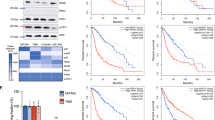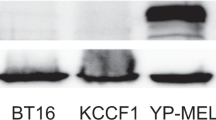Abstract
Standard treatment for glioblastoma multiforme and other brain tumors consists of surgical resection followed by combined radio-/chemotherapy. However, radiation resistance of tumor cells limits the success of this treatment, and the tumors invariably recur. Therefore, the selective inhibition of molecular mediators of radiation resistance may provide therapeutic benefit to the patient. One of these targets is the Rad51 protein, which is a key component of the homologous recombinational repair of DNA double-strand breaks. Here, we investigated whether post-transcriptional silencing of Rad51 by herpes simplex virus-type 1 (HSV-1) amplicon vector-mediated short interfering RNA expression can enhance the antitumor effect of radiation therapy. We demonstrate that these vectors specifically and efficiently inhibited the radiation-induced recruitment of Rad51 into nuclear foci in human glioma cells. The combination of vector-mediated silencing of Rad51 expression and treatment with ionizing radiation resulted in a pronounced reduction of the survival of human glioma cells in culture. In athymyc mice, a single intratumoral injection of Rad51-specific HSV-1 amplicon vector followed by a single radiation treatment resulted in a significant decrease in tumor size. In control animals, including mice that received an intratumoral injection of Rad51-specific amplicon vector but no radiation treatment, the tumor sizes increased.
This is a preview of subscription content, access via your institution
Access options
Subscribe to this journal
Receive 12 print issues and online access
$259.00 per year
only $21.58 per issue
Buy this article
- Purchase on Springer Link
- Instant access to full article PDF
Prices may be subject to local taxes which are calculated during checkout






Similar content being viewed by others
References
Kleihues P, Cavenee WK . Pathology and Genetics of Tumours of the Nervous System (WHO). IARC Press: Lyon, 2000.
Preston-Martin S . Epidemiology of gliomas. In: Berger MS, Wilson CD (eds). The Gliomas. Saunders: Philadelphia, PA, 1999, pp 2.
Maher EA, Furnari FB, Bachoo RM, Rowitch DH, Louis DN, Cavenee WK et al. Malignant glioma: genetics and biology of a grave matter. Genes Dev 2001; 15: 1311–1333.
Belli M, Sapora O, Tabocchini MA . Molecular targets in cellular response to ionizing radiation and implications in space radiation protection. J Radiat Res (Tokyo) 2002; 43 (Suppl): S13–S19.
Chen G, Yuan SS, Liu W, Xu Y, Trujillo K, Song B et al. Radiation-induced assembly of Rad51 and Rad52 recombination complex requires ATM and c-Abl. J Biol Chem 1999; 274: 12748–12752.
Bonner JA, Harari PM, Giralt J, Azarnia N, Shin DM, Cohen RB et al. Radiotherapy plus cetuximab for squamous-cell carcinoma of the head and neck. N Engl J Med 2006; 354: 567–578.
Stupp R, Mason WP, van den Bent MJ, Weller M, Fisher B, Taphoorn MJ et al. Radiotherapy plus concomitant and adjuvant temozolomide for glioblastoma. N Engl J Med 2005; 352: 987–996.
Cahill D, Connor B, Carney JP . Mechanisms of eukaryotic DNA double strand break repair. Front Biosci 2006; 11: 1958–1976.
Johnson RD, Jasin M . Sister chromatid gene conversion is a prominent double-strand break repair pathway in mammalian cells. EMBO J 2000; 19: 3398–3407.
Yuan ZM, Huang Y, Ishiko T, Nakada S, Utsugisawa T, Kharbanda S et al. Regulation of Rad51 function by c-Abl in response to DNA damage. J Biol Chem 1998; 273: 3799–3802.
Sonoda E, Sasaki MS, Buerstedde JM, Bezzubova O, Shinohara A, Ogawa H et al. Rad51-deficient vertebrate cells accumulate chromosomal breaks prior to cell death. EMBO J 1998; 17: 598–608.
Shinohara A, Ogawa H, Ogawa T . Rad51 protein involved in repair and recombination in S. cerevisiae is a RecA-like protein. Cell 1992; 69: 457–470.
Tutt A, Connor F, Bertwistle D, Kerr P, Peacock J, Ross G et al. Cell cycle and genetic background dependence of the effect of loss of BRCA2 on ionizing radiation sensitivity. Oncogene 2003; 22: 2926–2931.
Tashiro S, Walter J, Shinohara A, Kamada N, Cremer T . Rad51 accumulation at sites of DNA damage and in postreplicative chromatin. J Cell Biol 2000; 150: 283–291.
Haaf T, Raderschall E, Reddy G, Ward DC, Radding CM, Golub EI . Sequestration of mammalian Rad51-recombination protein into micronuclei. J Cell Biol 1999; 144: 11–20.
Liu Y, Maizels N . Coordinated response of mammalian Rad51 and Rad52 to DNA damage. EMBO Rep 2000; 1: 85–90.
Noguchi M, Yu D, Hirayama R, Ninomiya Y, Sekine E, Kubota N et al. Inhibition of homologous recombination repair in irradiated tumor cells pretreated with Hsp90 inhibitor 17-allylamino-17-demethoxygeldanamycin. Biochem Biophys Res Commun 2006; 351: 658–663.
Raderschall E, Stout K, Freier S, Suckow V, Schweiger S, Haaf T . Elevated levels of Rad51 recombination protein in tumor cells. Cancer Res 2002; 62: 219–225.
Vispe S, Cazaux C, Lesca C, Defais M . Overexpression of Rad51 protein stimulates homologous recombination and increases resistance of mammalian cells to ionizing radiation. Nucleic Acids Res 1998; 26: 2859–2864.
Collis SJ, Tighe A, Scott SD, Roberts SA, Hendry JH, Margison GP . Ribozyme minigene-mediated RAD51 down-regulation increases radiosensitivity of human prostate cancer cells. Nucleic Acids Res 2001; 29: 1534–1538.
Ohnishi T, Taki T, Hiraga S, Arita N, Morita T . In vitro and in vivo potentiation of radiosensitivity of malignant gliomas by antisense inhibition of the RAD51 gene. Biochem Biophys Res Commun 1998; 245: 319–324.
Taki T, Ohnishi T, Yamamoto A, Hiraga S, Arita N, Izumoto S et al. Antisense inhibition of the RAD51 enhances radiosensitivity. Biochem Biophys Res Commun 1996; 223: 434–438.
Russell JS, Brady K, Burgan WE, Cerra MA, Oswald KA, Camphausen K et al. Gleevec-mediated inhibition of Rad51 expression and enhancement of tumor cell radiosensitivity. Cancer Res 2003; 63: 7377–7383.
Miyagishi M, Hayashi M, Taira K . Comparison of the suppressive effects of antisense oligonucleotides and siRNAs directed against the same targets in mammalian cells. Antisense Nucleic Acid Drug Dev 2003; 13: 1–7.
Tijsterman M, Plasterk RH . Dicers at RISC; the mechanism of RNAi. Cell 2004; 117: 1–3.
Yokota T, Miyagishi M, Hino T, Matsumura R, Tasinato A, Urushitani M et al. siRNA-based inhibition specific for mutant SOD1 with single nucleotide alternation in familial ALS, compared with ribozyme and DNA enzyme. Biochem Biophys Res Commun 2004; 314: 283–291.
Dorsett Y, Tuschl T . siRNAs: applications in functional genomics and potential as therapeutics. Nat Rev Drug Discov 2004; 3: 318–329.
Saydam O, Glauser DL, Heid I, Turkeri G, Hilbe M, Jacobs AH et al. Herpes simplex virus 1 amplicon vector-mediated siRNA targeting epidermal growth factor receptor inhibits growth of human glioma cells in vivo. Mol Ther 2005; 12: 803–812.
Ito M, Yamamoto S, Nimura K, Hiraoka K, Tamai K, Kaneda Y . Rad51 siRNA delivered by HVJ envelope vector enhances the anti-cancer effect of cisplatin. J Gene Med 2005; 7: 1044–1052.
Saeki Y, Ichikawa T, Saeki A, Chiocca EA, Tobler K, Ackermann M et al. Herpes simplex virus type 1 DNA amplified as bacterial artificial chromosome in Escherichia coli: rescue of replication-competent virus progeny and packaging of amplicon vectors. Hum Gene Ther 1998; 9: 2787–2794.
Saeki Y, Fraefel C, Ichikawa T, Breakefield XO, Chiocca EA . Improved helper virus-free packaging system for HSV amplicon vectors using an ICP27-deleted, oversized HSV-1 DNA in a bacterial artificial chromosome. Mol Ther 2001; 3: 591–601.
Iliakis G . The role of DNA double strand breaks in ionizing radiation-induced killing of eukaryotic cells. Bioessays 1991; 13: 641–648.
Schwartz M, Zlotorynski E, Goldberg M, Ozeri E, Rahat A, le Sage C et al. Homologous recombination and nonhomologous end-joining repair pathways regulate fragile site stability. Genes Dev 2005; 19: 2715–2726.
Kelland LR, Edwards SM, Steel GG . Induction and rejoining of DNA double-strand breaks in human cervix carcinoma cell lines of differing radiosensitivity. Radiat Res 1988; 116: 526–538.
Walsh MJ, Shue G, Spidoni K, Kapoor A . E2F-1 and a cyclin-like DNA repair enzyme, uracil-DNA glycosylase, provide evidence for an autoregulatory mechanism for transcription. J Biol Chem 1995; 270: 5289–5298.
Nagelhus TA, Haug T, Singh KK, Keshav KF, Skorpen F, Otterlei M et al. A sequence in the N-terminal region of human uracil-DNA glycosylase with homology to XPA interacts with the C-terminal part of the 34-kDa subunit of replication protein A. J Biol Chem 1997; 272: 6561–6566.
Thacker J . The RAD51 gene family, genetic instability and cancer. Cancer Lett 2005; 219: 125–135.
McCabe N, Turner NC, Lord CJ, Kluzek K, Bialkowska A, Swift S et al. Deficiency in the repair of DNA damage by homologous recombination and sensitivity to Poly(ADP-ribose) polymerase inhibition. Cancer Res 2006; 66: 8109–8115.
Farmer H, McCabe N, Lord CJ, Tutt AN, Johnson DA, Richardson TB et al. Targeting the DNA repair defect in BRCA mutant cells as a therapeutic strategy. Nature 2005; 434: 917–921.
Rampling R, Cruickshank G, Papanastassiou V, Nicoll J, Hadley D, Brennan D et al. Toxicity evaluation of replication-competent herpes simplex virus (ICP 34.5 null mutant 1716) in patients with recurrent malignant glioma. Gene Therapy 2000; 7: 859–866.
Markert JM, Gillespie GY, Weichselbaum RR, Roizman B, Whitley RJ . Genetically engineered HSV in the treatment of glioma: a review. Rev Med Virol 2000; 10: 17–30.
Fraefel C, Song S, Lim F, Lang P, Yu L, Wang Y et al. Helper virus-free transfer of herpes simplex virus type 1 plasmid vectors into neural cells. J Virol 1996; 70: 7190–7197.
Herrlinger U, Jacobs A, Quinones A, Woiciechowsky C, Sena-Esteves M, Rainov NG et al. Helper virus-free herpes simplex virus type 1 amplicon vectors for granulocyte-macrophage colony-stimulating factor-enhanced vaccination therapy for experimental glioma. Hum Gene Ther 2000; 11: 1429–1438.
Lilley CE, Carson CT, Muotri AR, Gage FH, Weitzman MD . DNA repair proteins affect the lifecycle of herpes simplex virus 1. Proc Natl Acad Sci USA 2005; 102: 5844–5849.
Sandler VM, Wang S, Angelo K, Lo HG, Breakefield XO, Clapham DE . Modified herpes simplex virus delivery of enhanced GFP into the central nervous system. J Neurosci Methods 2002; 121: 211–219.
Lim DS, Hasty P . A mutation in mouse rad51 results in an early embryonic lethal that is suppressed by a mutation in p53. Mol Cell Biol 1996; 16: 7133–7143.
Tsuzuki T, Fujii Y, Sakumi K, Tominaga Y, Nakao K, Sekiguchi M et al. Targeted disruption of the Rad51 gene leads to lethality in embryonic mice. Proc Natl Acad Sci USA 1996; 93: 6236–6240.
Acknowledgements
We thank Kati Zlinszky for technical assistance. This work was supported in part by the Cancer League of Kanton Zurich, the Swiss National Science Foundation (No. 3100A0-100195), and the 6th FW European Molecular Imaging Laboratories (EMIL)-NoE for Combating Cancer (LSHC-CT-2004-503569).
Author information
Authors and Affiliations
Corresponding author
Rights and permissions
About this article
Cite this article
Saydam, O., Saydam, N., Glauser, D. et al. HSV-1 amplicon-mediated post-transcriptional inhibition of Rad51 sensitizes human glioma cells to ionizing radiation. Gene Ther 14, 1143–1151 (2007). https://doi.org/10.1038/sj.gt.3302967
Received:
Revised:
Accepted:
Published:
Issue Date:
DOI: https://doi.org/10.1038/sj.gt.3302967
Keywords
This article is cited by
-
A radiosensitizing effect of RAD51 inhibition in glioblastoma stem-like cells
BMC Cancer (2016)
-
Association between RAD 51 rs1801320 and susceptibility to glioblastoma
Journal of Neuro-Oncology (2016)
-
Evaluation and optimization of the administration of a selectively replicating herpes simplex viral vector to the brain by convection-enhanced delivery
Cancer Gene Therapy (2011)
-
Knockdown of Rad51 expression induces radiation- and chemo-sensitivity in osteosarcoma cells
Medical Oncology (2011)
-
Pseudovirions as Vehicles for the Delivery of siRNA
Pharmaceutical Research (2010)



